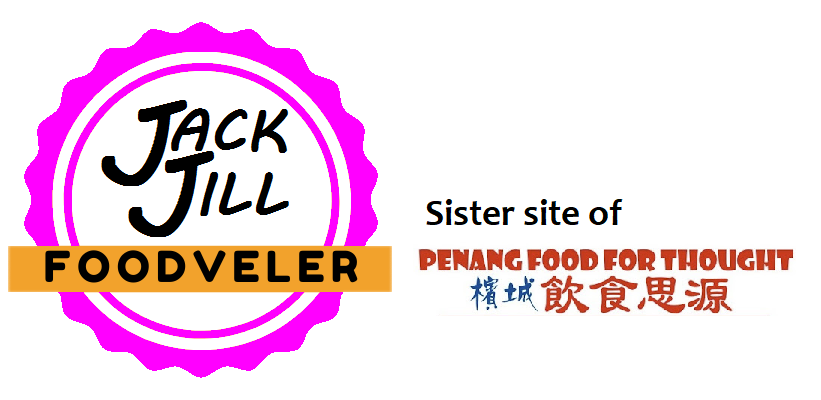 Special thanks to Cafe Ko Cha Bi Balik Pulau for extending this food review invitation.
Special thanks to Cafe Ko Cha Bi Balik Pulau for extending this food review invitation.
As far as food is concerned, Balik Pulau is famed for two things: asam laksa and durians. While durians are usually available on seasonal basis, asam laksa is available yearlong. Today’s trip brings me to Cafe Ko Cha Bi Balik Pulau (浮罗古早味) at the center of the town.
The eatery is furnished with wooden tables made from colorful planks. At one side of the wall is a painting of Balik Pulau scenery back in the old days. According to the proprietors, one of their goals is to preserve the nostalgia of Balik Pulau’s historical charm.
Cafe Ko Cha Bi Balik Pulau offers 2 types of laksa: Asam Laksa and Lemak Laksa. The former is renowned far and wide, but the latter has yet to receive mainstream recognition. In any case, the ingredients for both types of laksa are quite similar. They largely differ in soup recipes.
For Asam Laksa (亚参叻沙, RM4.00), tamarind (罗望子) is used to prepare the broth. This gives the soup a distinctive sense of sourness which characteristically defines this dish. Meanwhile, tuna is poached and flaked, then used to enrich the flavors of the broth. Usually mackerel is used for asam laksa, but I think tuna works as well.
The rice noodles used for this dish have rather springy texture. It is thicker than most types of Chinese noodles, but its porous texture allows the broth to penetrate the noodles thoroughly.
One key ingredient which helps to accentuate the sourness of the broth is ginger flower (姜花). Other fresh vegetables are cucumber, lettuce, mint leaves (薄荷叶) and pineapples. Dried chili (辣椒干) is used instead of bird’s eye chili (小辣椒). Optionally, there is also shrimp paste (虾膏) which helps bring out the flavor of Asam Laksa.
Compared to its popular cousin, Lemak Laksa (暹罗叻沙, RM4.00) is not as well-known but still worthwhile some attention. Using coconut milk to prepare the soup, this dish derives its appeal from its richer broth and heavier presence of aromatic spices.
Personally, I think Asam Laksa gives a bigger bang on the first sip. However throughout the course of the entire bowl, Lemak Laksa derives different form of appeal from its creamier broth. I suggest that you try both types and decide which one you prefer.
Cafe Ko Cha Bi Balik Pulau is operated by ethnic Hakkas (客家人), which explains why Hakka dishes are also available here. In fact, Balik Pulau has the highest concentration of Hakkas in Penang. Therefore, it is only fair to see how the Hakka Noodles (客家面, RM4.50) fare at this restaurant.
The plate of Hakka Noodles includes minced pork (肉碎), soy egg (卤蛋), soy bean curd (卤豆腐干) and cloud ear fungus (木耳). As far as seasoning is concerned, Hakka condiments tend to use stronger flavors. The restaurant also prepares its own chili sauce, which is maroon in color due to the use of red onions.
Meanwhile, the noodles are prepared fresh from dough, not from readily-made ones. This explains why the noodles have such delightful springiness. It is so delectable that I finished the entire bowl in no time.
The noodles are flavored with black sesame seeds (黑芝麻), which explains why they are gray in color. Other choices for noodles are pumpkin (金瓜) and pandan (香兰). Using hand-crank steamrollers, the dough is flattened and cut into long noodle strands. If you are really hungry, double the amount of noodles for only RM1.50!
The proprietors of Cafe Ko Cha Bi Balik Pulau also produce their own nutmeg juice. Current supply is limited to in-house consumption only. Eventually, the restaurant will be introducing bottled nutmeg too. This glass of Nutmeg Juice (豆蔻水, RM2.00) is made from white nutmeg, which is blended instead of being boiled for the case of red nutmeg.
For something fancier, order a tall glass of Nutmeg Smoothies (豆蔻冰沙, RM4.00). Slushy ice is blended with nutmeg and passion fruit (百香果) cordial. Other cordial choices are blueberry (蓝莓) and kiwi (奇异果). The smoothies is not truly meant to quench thirst, but this cooling dessert is certainly welcomed during a hot afternoon.
Last but not least, Nutmeg Fried Ice (豆蔻炒冰, RM5.00) is made by “frying” nutmeg and mango (香芒) syrup on a heated pan. Heat produces thin sheets of packed ice, which are then folded over and served.
Vanilla ice cream, jelly cubes, crushed peanuts and chocolate drizzle are used as additional toppings. Occasionally, peanut ice cream is also available.
Overall, the food at Cafe Ko Cha Bi Balik Pulau is quite satisfying and surprisingly affordable. I think it is a viable place to visit while exploring the countryside around Balik Pulau. According to the proprietors, the eatery will introduce more Hakka dishes such as Yong Tau Foo (酿豆腐) in the near future.
Name: Cafe Ko Cha Bi Balik Pulau (浮罗古早味)
Address: 110, Jalan Balik Pulau, 11000 Balik Pulau, Pulau Pinang
Contact: 012-474-5178
Business hours: 10:00am-6:00pm, closed on Wednesdays
Website: https://www.facebook.com/CafeKoChaBi
Coordinates: 5.35149 N, 100.23581 E
Directions: Along the mountain road from Paya Terubong, drive till the end to the town center of Balik Pulau. Turn left at the junction. Cafe Ko Cha Bi Balik Pulau is one of the shops on the left. It faces an open car park which provides plenty of parking spaces.



